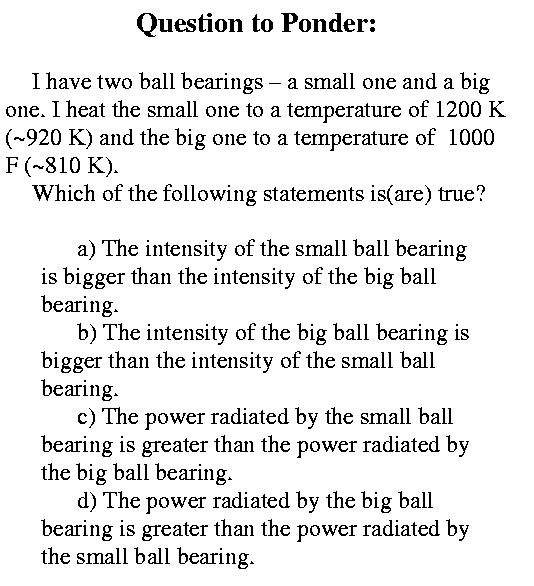|
|
There were lines on the mirror Lines on her face She pretended not to notice She was caught up in the race Eagles, Life in the Fast Lane |
Assignments:Problem Set #2 due Thursday 4 February 5pm
Read the remainder of Chapter 23 (pp. 372-378) for Monday's class |

In Class:
ponderous question
- difference between intensity (how bright each bit of the object is)
and power radiated (how much light comes out of the whole thing)
- depends on the size of the object
bright little things don't emit much power
big things, even when dim, can put out power.
- can't tell how much power is radiated without knowing the size
(really the surface area of the radiator)
----
consider:
two spheres, one of radius 0.15 m (Basketball),
the other of radius 0.03 m (tennis ball)
heat basketball to 1000 K, tennis ball to 1200 K
-- what is the ratio of the power emitted by the
two spheres?
i.e., how much more power is emitted by the hotter one?
-- I = sigma T^4
I_bball = 5.68e-8 1000^4 = 5.67e4 W/m^2
I_tball = 5.68e-8 1200^4 = 1.18e5 W/m^2
-- each sq meter emits these amounts of power (or luminosity)
total power emitted is I * surface area
surface area of a sphere is 4 pi r^2
P_bball = I_bball * 4 pi r^2
= 5.67e4 * 4 * pi * 0.15^2
= 1.6e4 W, 16,000 W, or 16 kW
P_tball = I_tball * 4 pi r^2
= 1.18e5 * 4 * pi * 0.03^2
= 1.30e3 W, or 1300 W, or 1.3 kW
Even though the tennis ball is hotter (and therefore has a higher intensity),
the basketball emits more power because it has more surface area
MORAL OF THE STORY: If you're interested in how much power something emits,
temperature isn't the only factor. You also need to know how big it is.
---------
So, we can take the temperatures of stars pretty easily using the
information from the Planck (a.k.a. blackbody) function
-- find the Planck fn which "fits" the observed spectrum best.
-- we discover that stars have T's like 3000 K to 30000K
and sometimes a little higher
-- this tells us a little about what they're made of
(ie., probably not ice)
-- however, since the BB fn is independent of composition
(recall table, chair, and you all emit a spectrum according to
your temp)
we can't really tell exactly what the stars are
made of from this information
----------------
But wait, there's more information available in a star's spectrum.
note bumps and wiggles; they're real
-- stars' spectra don't follow exactly the Planck function
-- there are "lines" in the spectrum
-- show another display (color); now they really look like
lines; that's why they're called spectral lines
What causes these features in the spectrum?
another type of interaction between matter and light
A TOTALLY DIFFERENT WAY TO CREATE LIGHT
>>>>demo -- He discharge tube and diffration gratings<<<<
"line" emission
low density - not rubbin elbows
- instead each atom is more or less free
of it's neighbors
- you're seeing emission from individual
atoms, not the interconnected
structures we call solids
spectral line emission
- microscopic process
determined more by composition
- each atom has a different composition
- nucleus and electron
- nucleus: protons and neutrons -> positive charge
- electron: dinky; has negative charge
- how an atom absorbs depends the details of on atomic structure
- changes in structure of the atom
- specifically in the behavior of the electrons
surrounding the nucleus
- electrons like the nucleus
- takes energy to pull them away
- we say that the atom is in a higher energy state
when the electron is further from the atom
- absorption of a photon provides the energy to move the
electron outward
--> raises the atom to a higher energy state
- emission of a photon is the result of a lowering
of the atom's energy
-- electron moves closer to nucleus
-- energy lost from atom in the form of a photon
quantization of energy states
- electron can't move to just any location
- only a few stable states available
- changes in energy of the atom are discrete and quantized
--> therefore, emission and absorption can only occur at
discrete wavelengths
|
![]()